Памуккале в Турции – известный термальный источник, расположенный в юго-западной части страны. В его воде чрезвычайно много карбоната кальция, который за тысячелетия помог сформировать естественные террасы, ванны и сталактиты. Рядом с Памуккале находятся руины древнегреческого города Иераполиса. Вместе они давно внесены в знаменитый список ЮНЕСКО и представляют собой огромный туристический центр Турции, ежегодно посещаемый миллионами туристов.
Здесь мы подробно расскажем, что это за термальные источники, чем они полезны для организма человека? Как проводятся экскурсии в Памуккале, что интересного можно увидеть и узнать, какие даются советы туристам и пр.
Описание термальных источников Памуккале
На этой территории насчитывается почти два десятка источников с температурой воды от 35C до 100C, они и формируют белые террасы. Вода из источников поднимается из-под земли, по искусственным руслам проходит к склону и спускается по нему в речную долину.
В ходе течения воды постепенно оседает более тяжелый карбонат кальция, он со временем затвердевает, образуя чисто белые террасы. Чтобы не мешать этому многолетнему процессу, доступ посетителей сегодня ко многим источникам закрыт.
Карта Памуккале в Турции
Карта Памуккале
История Памуккале в Турции
Эти источники открыли несколько тысячелетий назад древние греки. Во 2 веке до н.э. около них был возведен город Иераполис, в частности, были построены амфитеатр, храмы, бани и прочие сооружения.
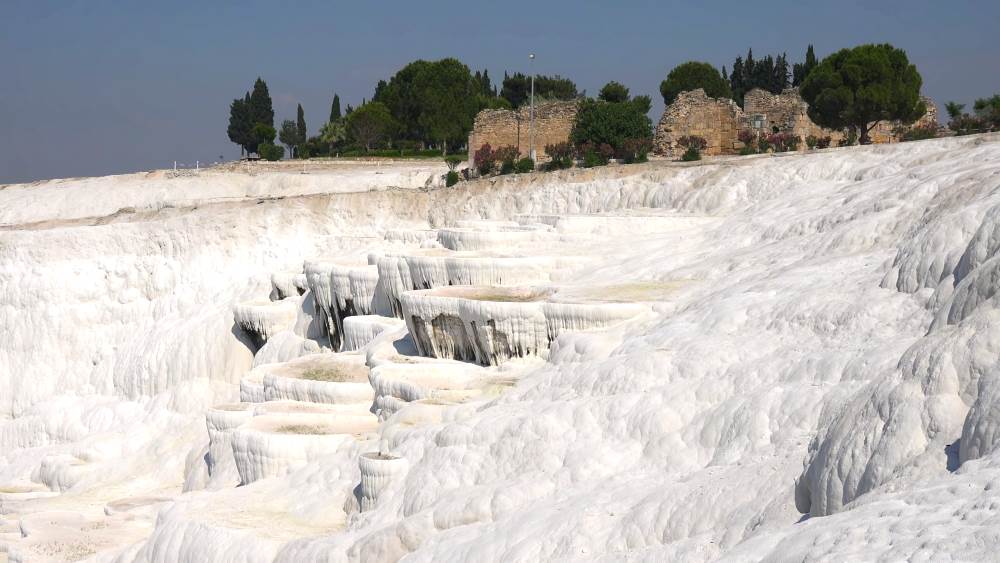
В 7 столетии на этой территории произошло сильное землетрясение, в результате чего появилась впадина, античный бассейн или бассейн Клеопатры, заполненный чистейшей родниковой минеральной водой. По сути, это прогретая вода из артезианской скважины.
Эта вода полезна при терапии болезней сердца и кровеносных сосудов, рахите и пр. В ходе экскурсии в Памуккале или по рекомендации врача многие туристы посещают этот водоем, окунаются в нем. Для этого нужно купить отдельный билет.
Сегодня в Турции город Иераполис и горячие источники Памуккале с террасами являются единой культурной и природной достопримечательностью, куда ежегодно приходят миллионы туристов, оплачивая единый билет.
История Иераполиса
Первые строения появились на этом месте не менее 4 тысячелетий назад, но свое имя город получил только во 2 веке до н.э. В эти времена Иераполис был заново построен греками после землетрясения. Полвека спустя, он стал частью Древнего Рима.
Накануне наступления новой эры около Иераполиса вновь произошло землетрясение, принёсшее много человеческих жертв и разрушений. Город опять был отстроен и приобрел славу замечательного курорта на минеральных водах.
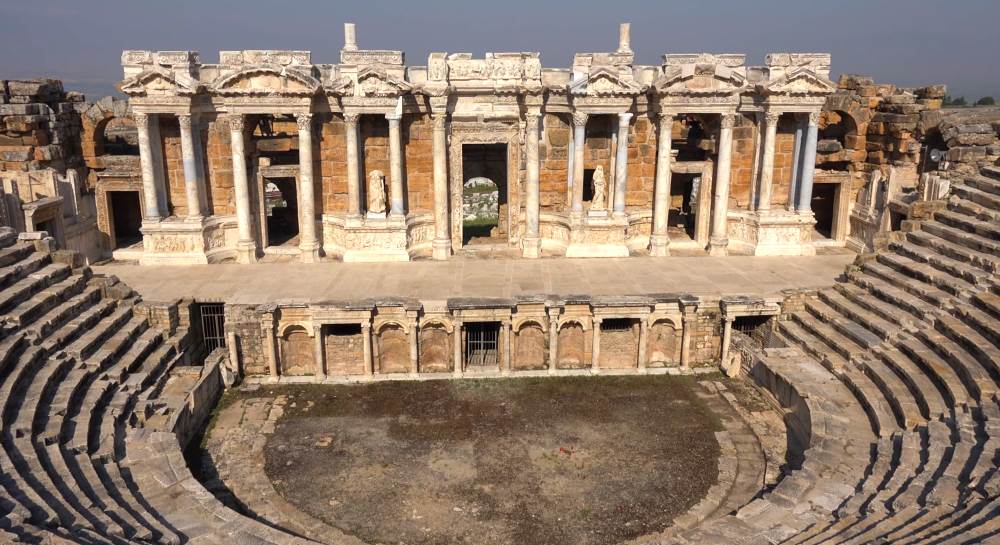
Иераполис сыграл значительную роль в укреплении и распространении христианства. Здесь был распят вниз головой и погиб в мучениях св. Филипп из Вифсаиды, один из 12 апостолов Иисуса Христа.
Значительно позже император Константин приказал сделать Иераполис центром епископства. В конце 4 века город перешел под власть Византии, а в конце 11 века был отдан турецкому султану. Позже он неоднократно переходил из рук в руки.
Только в начале 13 века Иераполис окончательно стал принадлежать турецкому султану. А в середине 14 века здесь случилось страшное землетрясение, окончательно похоронившее этот древний греческий полис.
Впервые археологические раскопки в Иерапролисе были произведены немецкими археологами в конце 19 века. Вновь принялись изучать этот город только в 50-е годы прошлого века археологи из Италии.
Как добраться в Памуккале?
Ближайший к Памуккале турецкий международный аэропорт называется Денизли. Сюда ежедневно прилетает три рейса из Стамбула. От Денизли можно за час доехать на автобусе или такси до Памуккале, расстояние – 64 км.
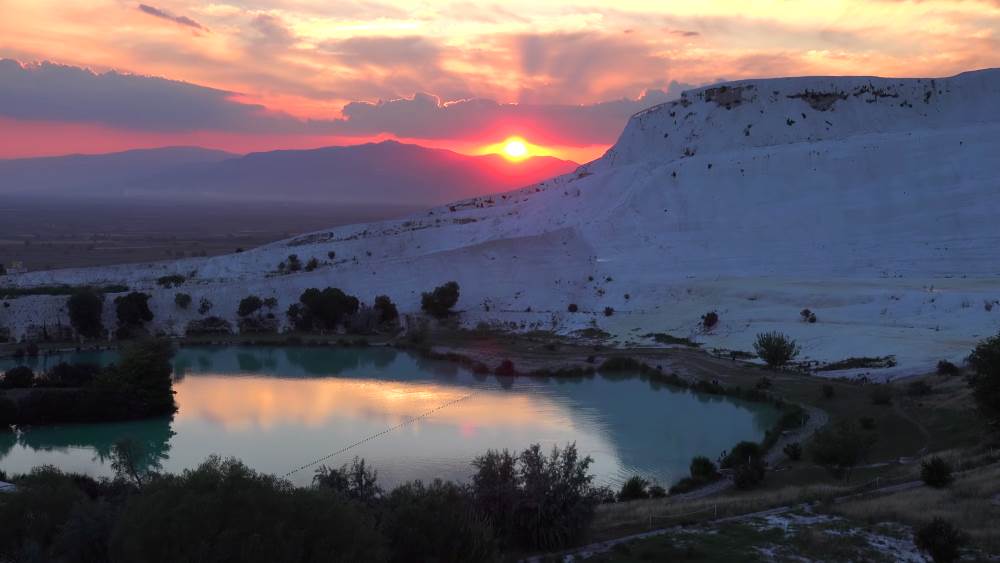
Чтобы добраться из Антальи в Памуккале, потребуется не менее 5 часов, поэтому на экскурсию в Памуккале нужно запланировать около двух суток. Дороги здесь хорошие, автобусные рейсы и такси – к Вашим услугам.
Можно добраться из Стамбула в Памуккале через аэропорт Измир. Из стамбульского аэропорта Ататюрка долететь до Измира, а оттуда продвигаться на поезде или автобусе. Причем на поезде можно доехать только до Денизли.
В Турции хорошо развито автобусное сообщение по всей стране, поэтому в Памуккале легко добраться практически из любого турецкого города.
Расписание и билеты Вы найдете на сайте https://www.neredennereye.com/.
Экскурсии в Памуккале
Памуккале – одна из самых интересных и востребованных достопримечательностей в Турции, а экскурсии к этому минеральному курорту пользуются огромной популярностью. В Высокий сезон здесь ежедневно море туристов.
Когда лучше ехать?
Поэтому лучше приехать в Памуккале под вечер, найти номер в отеле или забронировать его заблаговременно, переночевать, а наутро прийти на источники пораньше, пока не приехали в 11 часов толпы туристов из Антальи.
Вы увидите несказанную красоту, не стоит ее портить толпой народ. От Памуккале веет северной прохладой, поэтому лучше осматривать все эти террасы утром, а не в полуденный турецкий зной.
Сколько стоит?
- Билет для осмотра Памуккале и Иераполиса стоит 35 турецких лир или $6,72.
- Детский билет до 12 лет – 13 лир или $2,5.
- Детский билет до 6 лет – бесплатно.
- Билет за вход в археологический музей – 5 лир или $0,96
- Билет за вход в бассейн Клеопатры – 32 лиры или $6,14.
Эти билеты считаются в Турции лидерами продаж, многие туристы приезжают сюда по нескольку раз, настолько поражает их это природное чудо. Многие даже не раздумывают, отправлять ли вновь на экскурсию в Памуккале.
Такие экскурсии рассчитаны на один и два дня. Причем однодневную экскурсию берут те, кто приехал в Турцию всего на несколько дней. У кого имеется больше времени, предпочитают двухдневную экскурсию в Памуккале.
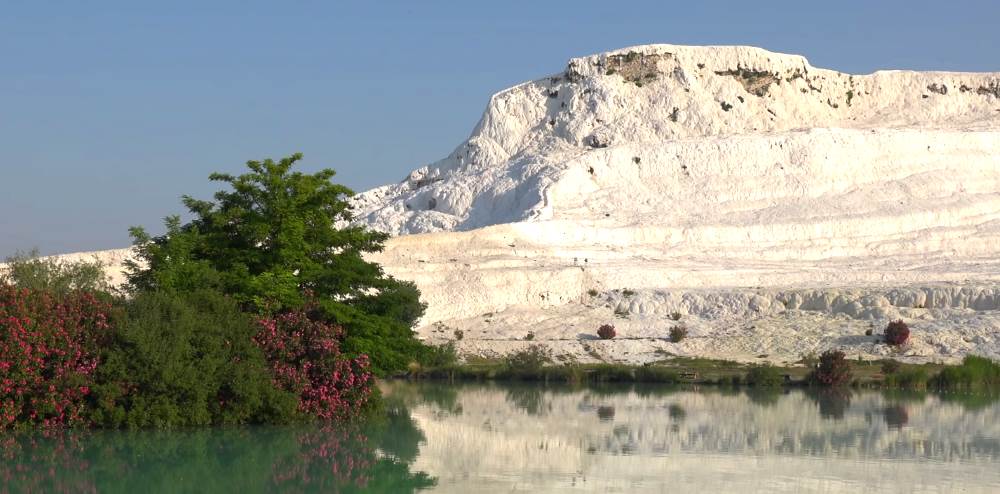
Бывавшие здесь туристы предпочитают двухдневную экскурсию, т.к. за это время можно получить больше полезной и интересной информации об объекте, внимательней его осмотреть и при этом не слишком торопиться.
Стоимость однодневной экскурсии на Памуккале у туроператоров составляет $80 или 416 турецких лир, а двухдневной — $140 или 730 лир. Туристам предоставляется профессиональный экскурсовод и комфортабельный шаттл.
Часто такие экскурсии продаются на улицах курортных городков Турции представителями «уличных» туристических агентств. Здесь Вы рискуете заранее заплатить за некачественные туристические услуги, зато сэкономите не менее $40.
Советы по организации тура
- Автобус приедет за туристами рано утром, т.к. от ближайшего курорта на Эгейском море не менее 150 км. Расстояние от Антальи до Памуккале по прямой – около 170 км. Потом придется объехать отели и собрать всех туристов, заплативших за экскурсию.
- Время поездки в одну сторону займет не менее трех часов, поэтому не советуем брать с собой на экскурсию маленьких детей. Они просто устанут от такой длительной поездки, хотя предоставляются вполне комфортабельные и современные автобусы.
- Помните, что в ходе экскурсии по Памуккале Вам предстоит пешком пройти значительное расстояние по местности, в т.ч. по скользким плоскостям террас, что требует хорошей спортивной подготовки.
- Обязательно возьмите с собой прохладную воду, лучше всего в термосе, т.к. пик экскурсии приходится на послеобеденный зной, а в заповеднике Вы не скоро найдете магазинчики или кафе, где можно охладиться.
- В Памуккале на открытом пространстве, без зеленых насаждений температура воздуха днем может достигать +50C. Одевайте удобную одежду, закрывающую открытые участки кожи, чтобы не сгореть, а также шляпу или панаму и мягкую обувь.
Что входит в состав экскурсии?
За заплаченные деньги Вас ждет поездка от курортного отеля до Памуккале и обратно, услуги гида и обед всей компанией. По пути экскурсовод расскажет вам об истории, и культуре древней Анатолии.
Во время остановок можно приобрести различные сувениры, а также книги и буклеты на русском языке, рассказывающие об уникальном заповеднике и минеральном курорте, который Вам предстоит посетить.
Сама экскурсия начинается с момента прибытия в Памуккале. Сначала экскурсионная группа осматривает руины древнего города Иераполиса, потом прогуливается по склону горы и белоснежным террасам, а напоследок – купается в бассейне Клеопатры.
Иераполис
В городе интересно будет посмотреть древний некрополь с остатками саркофагов и склепов. Некоторые хорошо сохранились, а другие прошли процедуру реставрации. Здесь же можно увидеть древние римские бани.
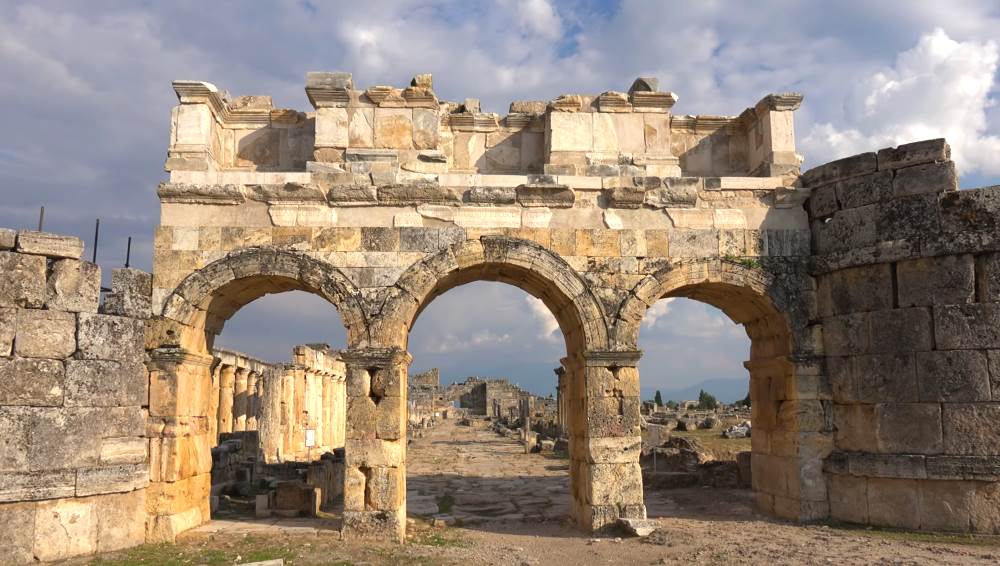
Будет интересно прикоснуться к крепостным воротам времен Древнего Рима и Византии, осмотреть настоящий, но частично разрушенный римский театр, остатки фонтанов и восстановленные археологами туалеты и пр.
Театр Иераполиса – самый крупный театр, построенный во времена античности и расположенный на территории современной Турции. В нем могли поместиться до 12 000 зрителей. Внутри театр отделан мрамором и украшен скульптурами.
Склоны горы
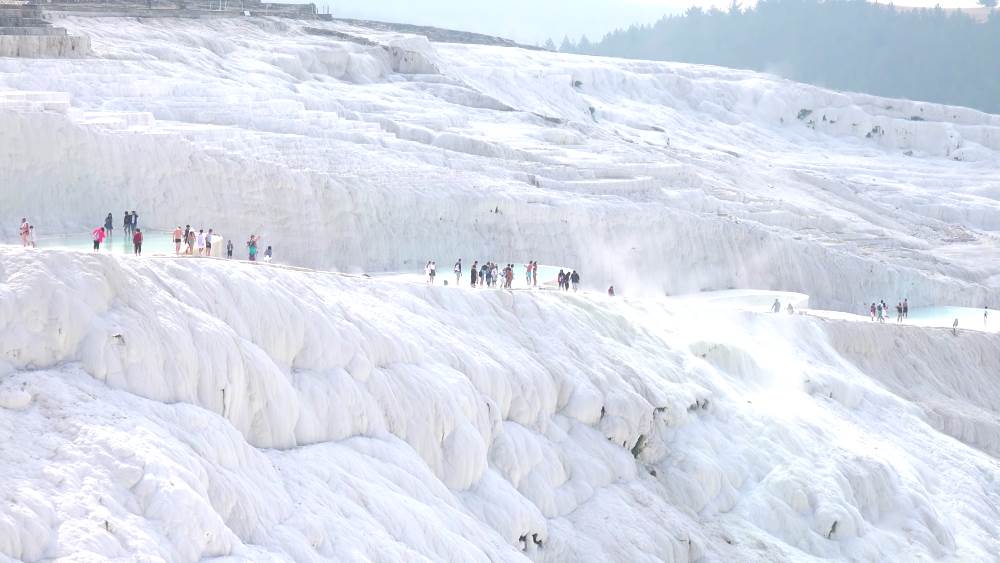
Они все покрыты налетом карбоната кальция, поэтому имеют белоснежный цвет. Имейте в виду, что здесь очень скользко. Обычно туристы снимают обувь и идут босиком вниз горы около полукилометра.
Купаться здесь можно только в одном источнике. Не пытайтесь отстать от группы и искупаться в другом месте. За туристами строго следят местные полицейские. Их цель: сохранить заповедник и его экологическую чистоту в первозданном виде.
Бассейн Клеопатры
До конца экскурсии остаётся час, и большинство туристов отправляется в этот бассейн, чтобы окунуться в его прохладные минеральные воды. Стоит это удовольствие $20, билеты можно купить тут же, в кассе.
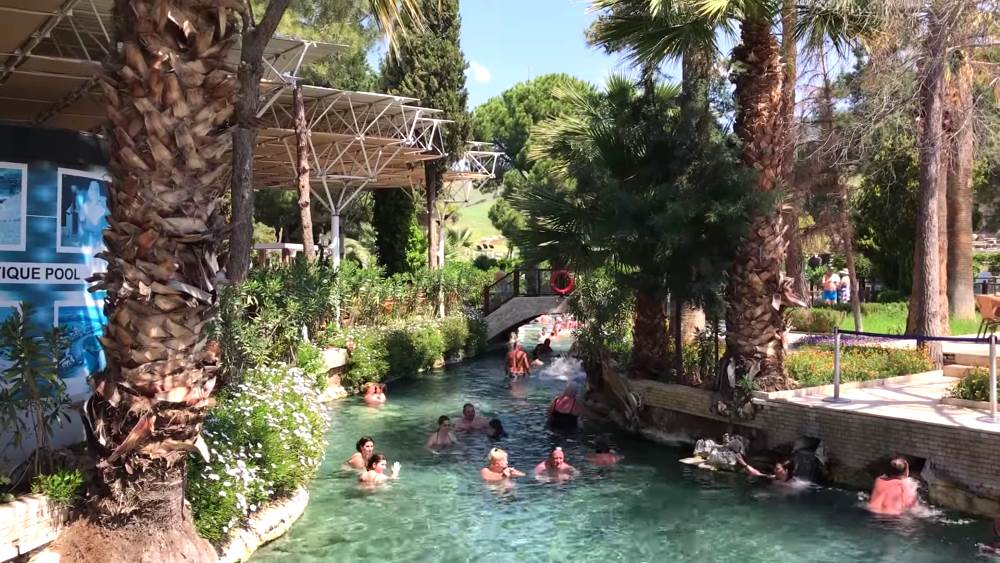
Недалеко от бассейна расположено кафе с кондиционером, там можно отдохнуть от жары, перекусить, выпить лимонада, просто привести себя в порядок. Мужчины охлаждают себя холодным пивом.
Если Вы не хотите искупаться в бассейне Клеопатры, можете вернуться в древний город Иераполис, он притягивает к себе многих туристов, подняться на вершину горы, осмотреть гробницу св. Апполона и пр.
Видеообзор экскурсии на Памуккале
Обратная дорога
Двигаться обратно после прогулки по Иераполису и Памуккале еще сложней, сказывается большая физическая нагрузка. Но нужно еще осмотреть местную фабрику оникса и побывать в винном погребке.
В качестве награды по окончанию экскурсии вечером Вас ждет вкуснейший ужин и долгожданный отдых. Вернетесь на свой турецкий курорт только поздним вечером, хотя еще сможете успеть на ужин.
Что еще можно посмотреть около Памуккале?
Совсем недалеко от горячих источников Памуккале и его белых террас можно посетить красные террасы Карахаит. Здесь тоже имеются горячие источники, также можно принять лечебные грязевые ванны.
Карта Памуккале и Карахаита
Аналоги Памуккале в мире
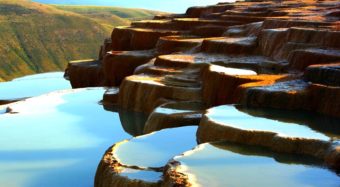
Такие белые террасы, созданные природой в Турции, не являются единственными в своем роде.
Нечто чрезвычайно похожее имеется:
- в Иране в Badab-e Surt;
- в Китае в провинции Юньнань, в Сычуани;
- в Италии, Венгрии;
- в США в Йеллоустоуне;
- в Мексике и др.
Отзывы о Памуккале
Вероника, Львов:
Это настоящее чудо света. Если окажетесь в Турции, обязательно посетите его, будете просто ошарашены. Кажется, что попал на другую планету. Это прекрасное, уникальное и загадочное место.
Аня, Истра, Московской области:
Такая экскурсия входит в турпакет. Думала, что-то нудное, дорога была долгой. Но когда попала на место, была невероятно восхищена. ЮНЕСКО совершенно обоснованно включил Памуккале в свой список.
Виктор, Сыктывкар:
Это замечательное место лечило людей еще в античные времена. Впервые попал на такие террасы, созданные матушкой природой, и постараюсь приехать сюда еще раз. Хотя для пожилых людей это тяжелое путешествие.
Алиса, Воркута:
Потрясающее место, удивительная экскурсия. Никогда бы и в голову не пришло, что подобные места существуют на свете. Настоятельно рекомендую всем побывать на Памуккале и в Иераполисе, не пожалеете.

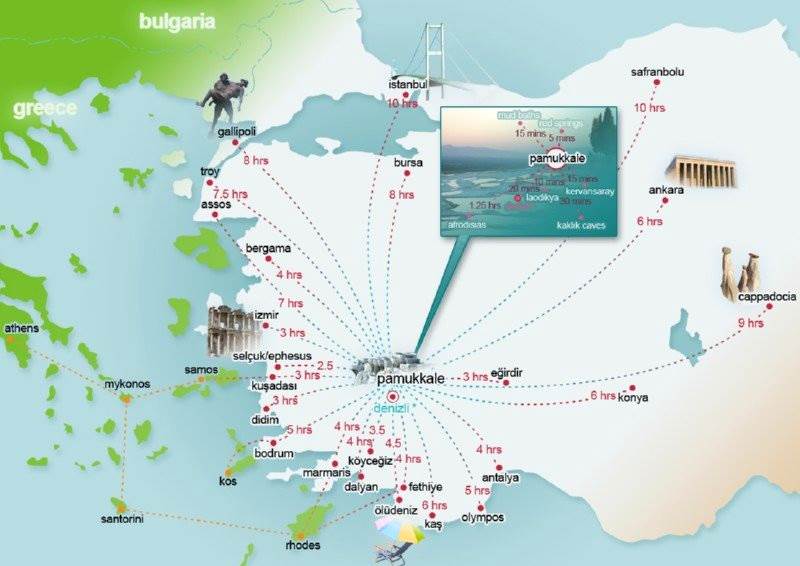
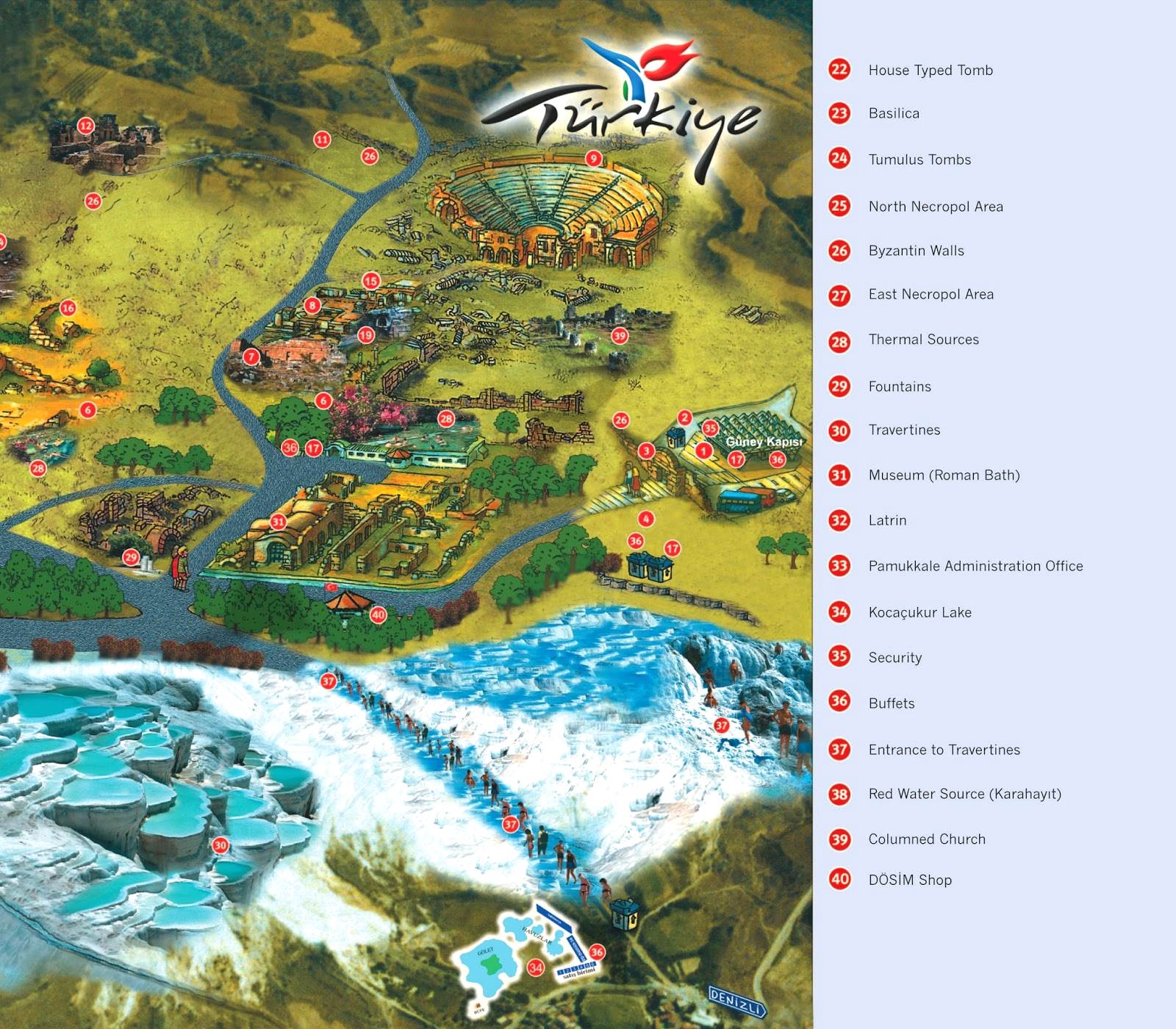
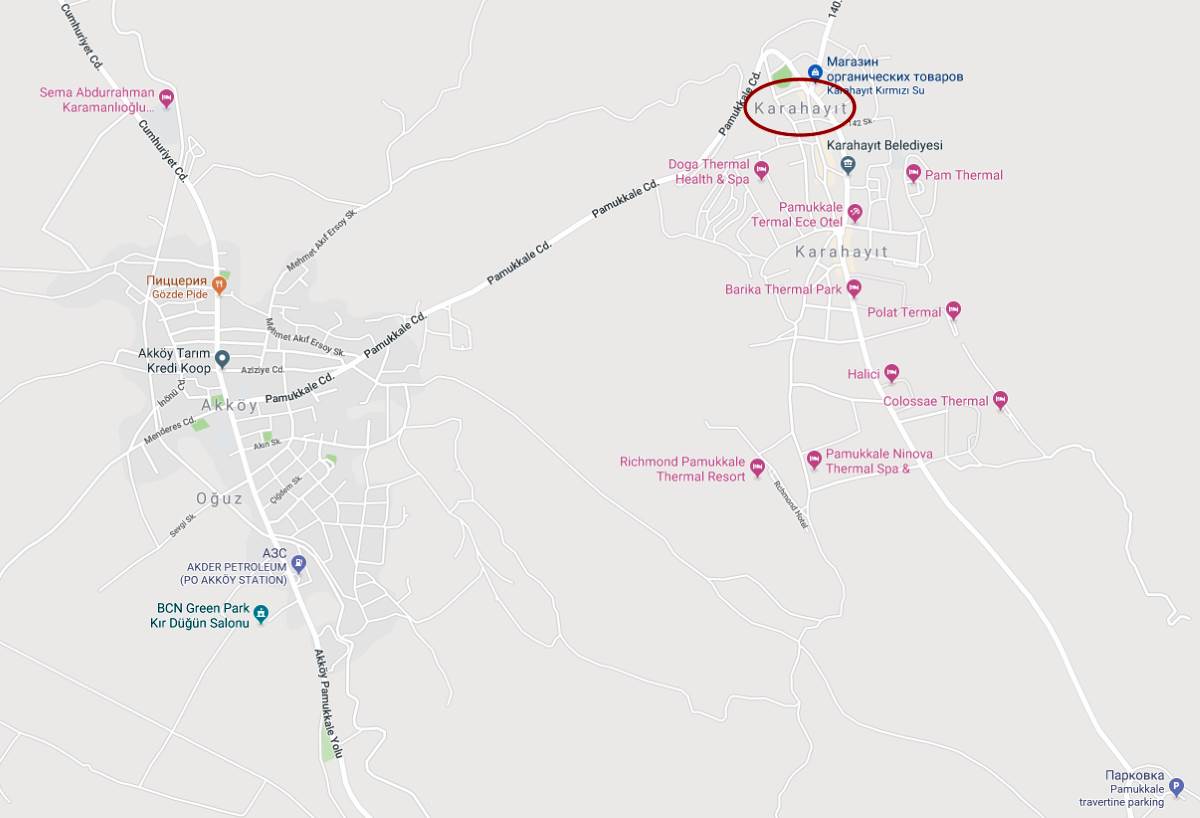
Ах, прекрасная Турция! Советую всем туристам, которые посещают Турцию, обязательно заглянуть на термальный источник под названием Памуккале. Перед вашим взором откроется неописуемая красота. Не зря ведь все-таки ЮНЕСКО включил данное место в список всемирного наследия. Можно искупаться в термальном источнике, богатом минеральными веществами, что полезно скажется на Вашем здоровье. Чудесное место, которое рекомендую всем к посещению.
Приехали в Памуккале всей семьей. Место очень красивое, множество видов, которые грех не увидеть и не сфотографировать. Больше всего понравился бассейн Клеопатры, но лучше туда приходить либо поздно вечером, либо рано утром, а то народы полно. Съездили в горы, очень красивые виды. Походили по развалинам. Если хотите увидеть что-то красивое и вместе с эти отдохнуть и взобраться на гору, то вам сюда.
Очень красивое место! Фото всегда получаются великолепные. Если есть возможность, то приезжайте не в сезон. В сезон просто толпа туристов. Вы найдете минутку, чтобы сделать красивое фото, но насладиться этим местом можно и без людей))) Осенью, например.